Garnished with chic designs and with a far-reaching menu aiming to update Chinese cuisine, Bird Wo Wo clearly wants to broaden the appeal of the culinary traditions of China. And if the customer demographic observed on a recent visit is of any indication, the establishment woos an international and young crowd. Its offerings, however, are hit and miss.
First-time diners could be forgiven for confusing the Chinese restaurant with a cafe intended to titillate a female clientele. Brightly lit, the interior has a sleek color scheme of iron gray and white, adorned with decorative, feather-shaped patterns, mirrors and hanging ornaments made of beads. Those who wish to snap selfies and shout “How cute!” (好可愛) amid young women and girls might be disappointed though. On the weekday evening my dining partners and I visited, the majority of the diners appeared to be youngish white-collar workers. A cacophony of languages was also heard. Next to our table, a group of Japanese-speaking, suit-wearing businessmen seemed to enjoy their meals with bottles of Taiwan beer (NT$150 per bottle). On the other side, several men and women with Singaporean accents discussed work over glasses of red wine.
As for the food, the restaurant’s kitchen is designed to appeal to as many customers as possible, covering various regional cuisines ranging from Jiangsu and Zhejiang to Szechuan and Cantonese. Traditional dishes are often given an innovative twist. The boiled sliced pork and cucumber with garlic sauce (爽口薄片晾衣, NT$290), for example, is a creative rendition of boiled pork with garlic sauce (蒜泥白肉), a staple plate of the Szechuan cuisine. The photogenic dish offered a surprisingly savory explosion of flavors in the mouth, mixing the thin slices of fat-streaked pork, the freshness of cucumbers with the thick dipping sauce of garlic and honey. It was our favorite course of the evening.
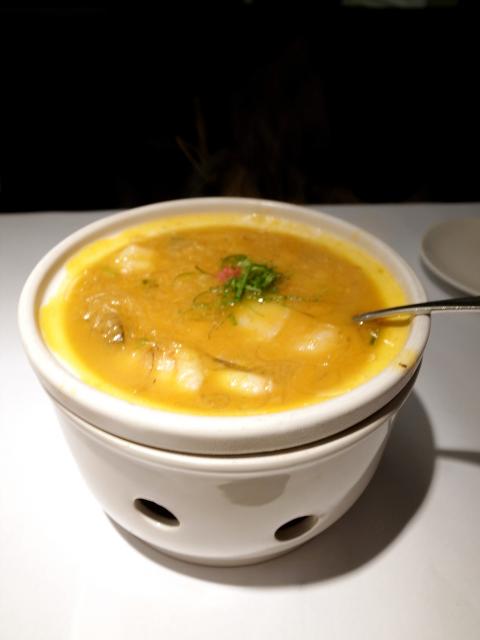
Photo: Ho Yi, Taipei Times
Another innovative attempt is the shaoxing millet bread with deep fried dry vegetables (紹興干菜窩窩頭, NT$320). Composed of preserved vegetables deep fried with pork and wrapped in brown sugar-flavored mantou (饅頭), or steamed buns, the dish was a saliva-inducing balance between the crispy, salty filling and the sweet, soft bun. The outer parts of the buns, however, were disappointingly soggy and left a blemish to the otherwise fun creation.
Recommended by our wait person, the braised dry pig skin with stinky tofu (美極皮肚臭豆腐, NT$360) didn’t impress with the less-than-ordinary quality of tofu, and the portion was skimpy for the price. Nor were we particularly enthusiastic about the braised crab roe with seafood and green bean noodle in casserole (蟹黃海鮮粉絲煲, NT$380), which was bland and dominated by sticky noodles.
Other popular dishes include deep-fried balsam pear (不像苦瓜, NT$280), deep-fried shrimp balls (灌湯黃金蝦球, NT$380), stewed pork with cabbage and eggs (提督官府燉菜, NT$380) and the chef special in casserole (宮廷一品皇罈子, NT$250), which features scallops, pig knuckle and king oyster mushrooms.
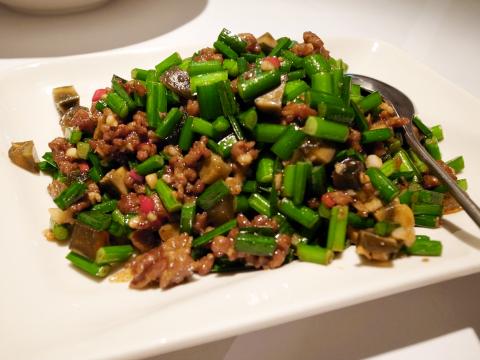
Photo: Ho Yi, Taipei Times
Surprisingly, the restaurant also has a small afternoon-tea menu filled with waffles, sandwiches, chocolate drinks and even a chocolate fondu. Why this Chinese restaurant wants to sell coffee and cake is anyone’s guess, but the Western-style offerings feel like an afterthought and might stretch the establishment’s creativity a bit too much.
Bird Wo Wo has several other venues — Neihu (內湖) and Tamsui (淡水) districts as well as in Greater Taichung and Greater Kaohsiung. For more information, visit the restaurant’s Web site at www.birdwowo.com.
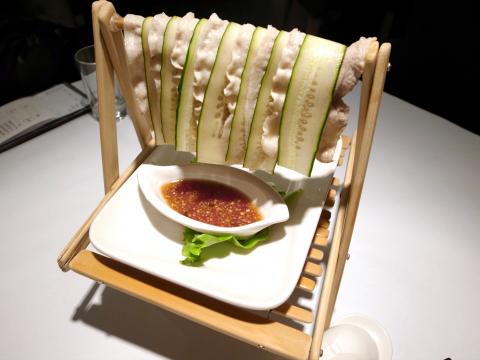
Photo: Ho Yi, Taipei Times
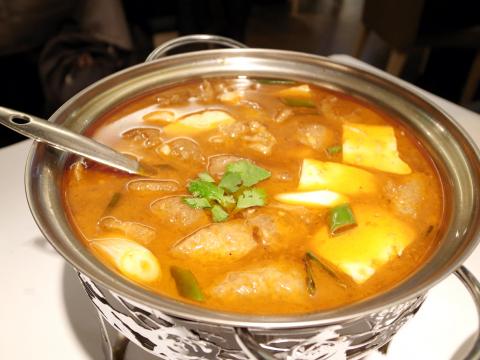
Photo: Ho Yi, Taipei Times
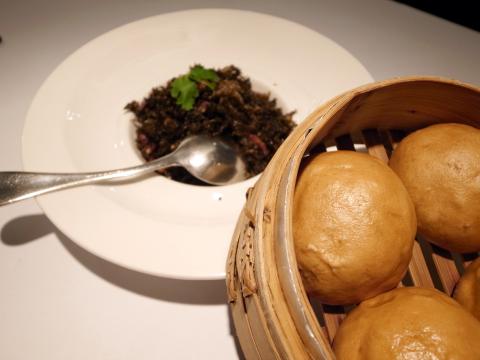
Photo: Ho Yi, Taipei Times

Next week, candidates will officially register to run for chair of the Chinese Nationalist Party (KMT). By the end of Friday, we will know who has registered for the Oct. 18 election. The number of declared candidates has been fluctuating daily. Some candidates registering may be disqualified, so the final list may be in flux for weeks. The list of likely candidates ranges from deep blue to deeper blue to deepest blue, bordering on red (pro-Chinese Communist Party, CCP). Unless current Chairman Eric Chu (朱立倫) can be convinced to run for re-election, the party looks likely to shift towards more hardline

Sept. 15 to Sept. 21 A Bhutanese princess caught at Taoyuan Airport with 22 rhino horns — worth about NT$31 million today — might have been just another curious front-page story. But the Sept. 17, 1993 incident came at a sensitive moment. Taiwan, dubbed “Die-wan” by the British conservationist group Environmental Investigation Agency (EIA), was under international fire for being a major hub for rhino horn. Just 10 days earlier, US secretary of the interior Bruce Babbitt had recommended sanctions against Taiwan for its “failure to end its participation in rhinoceros horn trade.” Even though Taiwan had restricted imports since 1985 and enacted

Last week the story of the giant illegal crater dug in Kaohsiung’s Meinong District (美濃) emerged into the public consciousness. The site was used for sand and gravel extraction, and then filled with construction waste. Locals referred to it sardonically as the “Meinong Grand Canyon,” according to media reports, because it was 2 hectares in length and 10 meters deep. The land involved included both state-owned and local farm land. Local media said that the site had generated NT$300 million in profits, against fines of a few million and the loss of some excavators. OFFICIAL CORRUPTION? The site had been seized

Enter the Dragon 13 will bring Taiwan’s first taste of Dirty Boxing Sunday at Taipei Gymnasium, one highlight of a mixed-rules card blending new formats with traditional MMA. The undercard starts at 10:30am, with the main card beginning at 4pm. Tickets are NT$1,200. Dirty Boxing is a US-born ruleset popularized by fighters Mike Perry and Jon Jones as an alternative to boxing. The format has gained traction overseas, with its inaugural championship streamed free to millions on YouTube, Facebook and Instagram. Taiwan’s version allows punches and elbows with clinch striking, but bans kicks, knees and takedowns. The rules are stricter than the